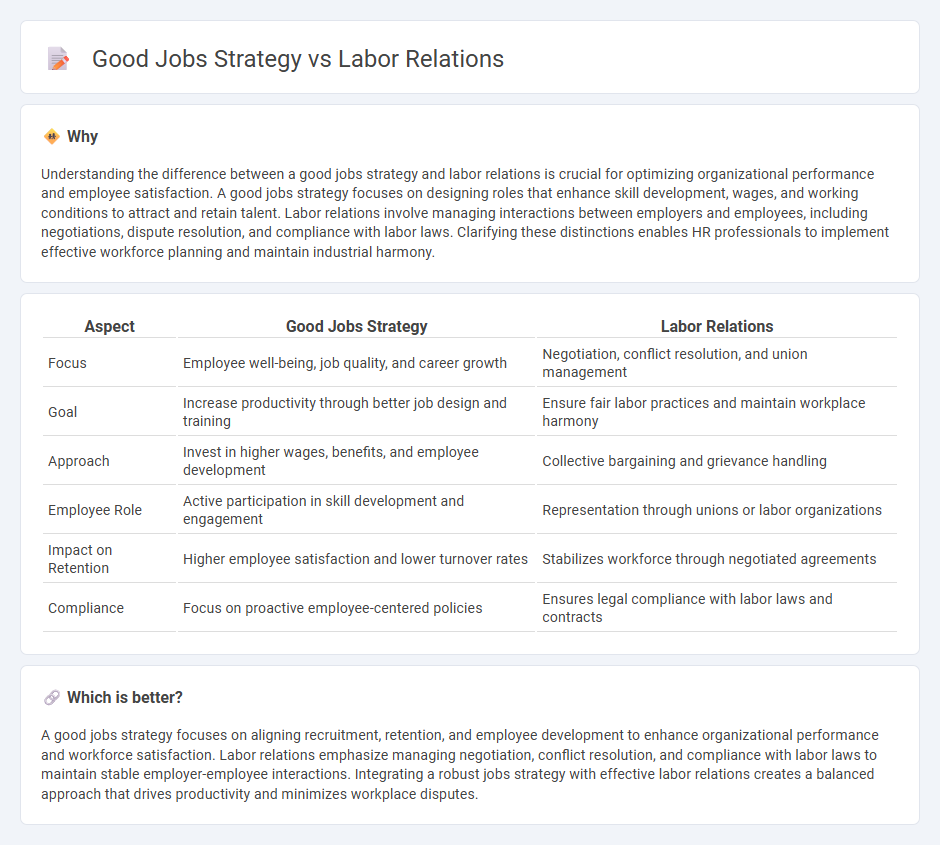
Effective human resources strategies balance talent acquisition, employee engagement, and performance management to foster organizational growth. Strong labor relations ensure compliance with labor laws, promote fair workplace practices, and mitigate conflicts between management and employees. Explore comprehensive approaches to align good jobs strategy with labor relations for sustainable business success.
Why it is important
Understanding the difference between a good jobs strategy and labor relations is crucial for optimizing organizational performance and employee satisfaction. A good jobs strategy focuses on designing roles that enhance skill development, wages, and working conditions to attract and retain talent. Labor relations involve managing interactions between employers and employees, including negotiations, dispute resolution, and compliance with labor laws. Clarifying these distinctions enables HR professionals to implement effective workforce planning and maintain industrial harmony.
Comparison Table
| Aspect | Good Jobs Strategy | Labor Relations |
|---|---|---|
| Focus | Employee well-being, job quality, and career growth | Negotiation, conflict resolution, and union management |
| Goal | Increase productivity through better job design and training | Ensure fair labor practices and maintain workplace harmony |
| Approach | Invest in higher wages, benefits, and employee development | Collective bargaining and grievance handling |
| Employee Role | Active participation in skill development and engagement | Representation through unions or labor organizations |
| Impact on Retention | Higher employee satisfaction and lower turnover rates | Stabilizes workforce through negotiated agreements |
| Compliance | Focus on proactive employee-centered policies | Ensures legal compliance with labor laws and contracts |
Which is better?
A good jobs strategy focuses on aligning recruitment, retention, and employee development to enhance organizational performance and workforce satisfaction. Labor relations emphasize managing negotiation, conflict resolution, and compliance with labor laws to maintain stable employer-employee interactions. Integrating a robust jobs strategy with effective labor relations creates a balanced approach that drives productivity and minimizes workplace disputes.
Connection
Effective jobs strategy aligns with labor relations by fostering transparent communication and trust between employers and employees, which enhances workforce stability and productivity. Strategic job design and fair labor practices reduce conflicts and improve employee satisfaction, driving organizational performance. Strong labor relations contribute to successful implementation of human resource strategies, ensuring a motivated and committed workforce.
Key Terms
**Labor Relations:**
Labor relations emphasize the management of employee-employer interactions through collective bargaining, dispute resolution, and adherence to labor laws to ensure workplace fairness and stability. This approach fosters strong communication channels between unions and management, reducing conflicts and improving job security. Explore the impact of effective labor relations on organizational productivity and employee satisfaction.
Collective Bargaining
Collective bargaining serves as the cornerstone of labor relations by enabling workers and employers to negotiate wages, working conditions, and benefits, fostering a balanced power dynamic. The Good Jobs Strategy complements this by advocating for higher wages, job security, and employee empowerment, enhancing productivity and retention through better labor relations. Explore how integrating collective bargaining into the Good Jobs Strategy can create sustainable workplace improvements.
Grievance Procedures
Effective grievance procedures are a cornerstone of both labor relations and the Good Jobs Strategy, providing structured mechanisms to address employee concerns and disputes promptly. In labor relations, transparent grievance processes help maintain trust and prevent workplace conflicts from escalating, while the Good Jobs Strategy emphasizes these procedures to enhance employee satisfaction and retention. Explore more on how robust grievance procedures bridge labor relations and high-quality job practices for a harmonious work environment.
Source and External Links
Labor relations - Wikipedia - Labor relations refers to the study and management of unionized employment settings involving employers, management, and unions, governed by federal and state laws that establish frameworks for collective bargaining and regulate unfair labor practices.
National Labor Relations Act - The National Labor Relations Act (NLRA) protects the right of private-sector employees to organize, bargain collectively, and seek better working conditions without fear of employer retaliation.
Labor Relations Specialists - Bureau of Labor Statistics - Labor relations specialists resolve disputes between workers and managers, negotiate collective bargaining agreements, and coordinate grievance procedures for employee complaints.
 dowidth.com
dowidth.com